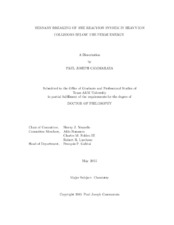| dc.description.abstract | Heavy-ion collisions have played an important role in probing the asymmetry term of the nuclear Equation of State (nEoS). As the bombarding energy increases from lower energies (~9 MeV/nucleon) to near the Fermi energy, the reaction mechanism transitions from deep-inelastic transfer reactions to those resulting in the multi fragmentation of the reaction system. In the energy regime between the two extremes, there is the possibility of observing the dynamical breaking of the system into a few heavy reaction partners. This feature, regardless of the energy or asymmetry of the reacting system, has been predicted to be sensitive to the asymmetry term of the nEoS through a number of theoretical predictions.
Recently, a new experiment has been conducted at the Texas A&M University Cyclotron Institute to explore the dynamical breaking of the reaction system at 15 MeV/nucleon. The reaction systems studied, 136Xe,124Sn+64Ni and 124Xe+58Ni, were chosen as they provide a wide range of isospin asymmetry. The forward array using silicon technology (FAUST) was coupled to a large quadrupole triplet spectrometer (QTS) to collect both the emitted intermediate mass fragments (Z ≥ 3) and the heavy, projectile-like remnant. This arrangement was designed, based on the predictions of numerous simulations, to be the most sensitive for detecting a three-body breakup of the reaction system.
Previously, experimental observations have shown a strong angular alignment in the dynamical breakup of the hot, projectile-like source. In this experiment, a dependence on the charge and isospin asymmetry of the entrance channel in this energy regime is noted. A modest dependence on the mass and energy of the quasi-projectile (QP) source has been shown to play a significant role in understanding the angular distributions of the breakup. This dependence has been shown to act as a surrogate for the impact parameter of the collision. Additionally, the velocity of the resultant projectile-like fragment plays a key role in sorting out the dynamical vs. statistical breaking of the reaction system, especially when compared to experimentally filtered theoretical simulations (CoMD+Gemini). These dynamical events have revealed a neutron enrichment of the IMFs emitted from near the neck region, on short time scales, in good agreement with previously published data.
The underlying shape of the hot QP has been predicted to be both sensitive to the asymmetry term of the nEoS and the driving force behind the few body breaking of the reaction system. Experimentally, being only able to detect the two resultant fragments of the QP breakup required the use of a surrogate method to qualitatively approximate the shape of the QP at the time of break-up. The dynamical events analyzed were, on average, the result of QPs with little deformation in velocity space. There was good agreement between the simulations and the experimental data.
Recently, a machine learning algorithm has been tested in an attempt to consider multiple observables predicted to be sensitive to the symmetry energy concurrently. Initial testing of the algorithm proved promising, utilizing unfiltered results from dynamical simulations. This technique has been extended to experimentally filtered simulation data with statistically significant results. Within experimental detector constraints, the simulations retain enough sensitivity for the machine learning algorithm to discriminate between the parameterizations of the symmetry energy. | en |


